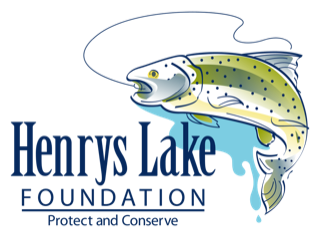
From Damon Keen IDFG.
I’ve had several questions regarding aeration at Henrys this winter and namely, “Why isn’t the F&G running the aerators?”
First off, identifying what the aeration system is supposed to do is necessary. The aerators on Henrys were installed in the early 1990’s, shortly after a winterkill event that was caused by low dissolved oxygen levels in the lake.
The system consists of 12-2″ PVC lines that fan out in front of the hatchery ladder and are located in staggered positions as far out as 400 yards from shoreline. At the end of the PVC lines aeration heads are attached. The system pushes air through these lines with the means of a 20hp electric motor attached to a large blower. When the system is running, the result is that air is forced through the lines, out the aeration heads, and a fountain of air bubbles to the surface above the heads.
The bubbling action brings warmer water from the lake bottom to the surface, where ice is melted. The newly formed open water can then be recharged with oxygen from the environment.
The system cannot recharge the entire lake with dissolved oxygen. Henrys is a large lake and the impacted area is relatively small. The system was designed to improve dissolved oxygen content in the immediate area of the hatchery. In the event of a major oxygen depletion event, the goal is to improve dissolved oxygen content enough so springtime spawning can be successful.
In the event of a major winterkill, the objective is to at least have sufficient eggs to restock the lake the following fall. Along with improving egg quality, our radio telemetry study in 2007 showed adult trout move along the shoreline during the winter making them more likely to encounter our aerators, which may help survival in stressful times.
Fortunately, with the data and research completed during the early 1990’s by Tom Herron, we have an excellent understanding of what to expect during the winter at Henrys Lake. Dissolved oxygen levels are monitored at several locations shortly after ice forms on the lake.
Monitoring is repeated at intervals and an evaluation is then made to determine if aeration should be deployed. Basically, the data collection points enable us to predict if sufficient dissolved oxygen levels will prevail until ice leaves the lake and natural recharge begins. This method of evaluation allowed us to predict early during the winter of 2003/04 that dissolved oxygen levels could become critical prior to ice off. Therefore, aeration was deployed. Fortunately this winter (2007/08), current dissolved oxygen levels remain good. And although evaluation is ongoing, to date (1/10/2008) aeration is not necessary and the aerators remain idle. The Idaho Fish and Game deploys aeration on poor or marginal dissolved oxygen years. However, winters where sufficient dissolve oxygen levels are present, the aerators collect a little dust. And that’s good.
